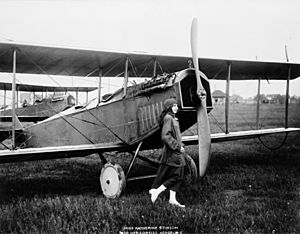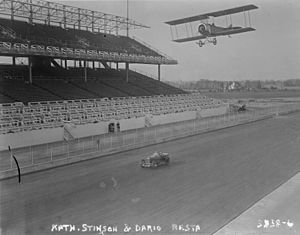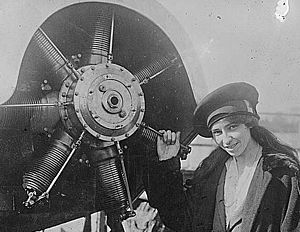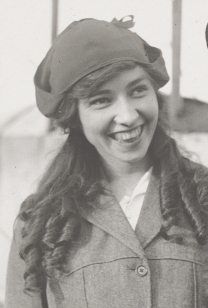Katherine Stinson facts for kids
Quick facts for kids
Katherine Stinson
|
|
|---|---|
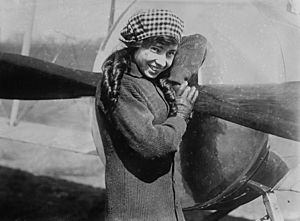 |
|
| Born | February 14, 1891 |
| Died | July 8, 1977 (aged 86) |
| Resting place | Santa Fe National Cemetery |
| Nationality | American |
| Known for | Aviator, stunt and exhibition flying |
| Spouse(s) | Miguel Antonio Otero, Jr. |
| Relatives | Marjorie Stinson Eddie Stinson |
| Aviation career | |
| First flight | January 1911 |
| Famous flights | First pilot to ever fly at night First female pilot to fly a loop First female to fly for the US Mail Service First female to fly in Canada and Asia |
| Flight license | July 24, 1912 Pine Bluff, AR |
Katherine Stinson (born February 14, 1891 – died July 8, 1977) was an amazing American pilot. In 1912, she became only the fourth woman in the United States to earn an official pilot's license from the FAI. Katherine set many flying records for amazing stunts, long distances, and staying in the air for a long time.
She was the first female pilot to work for the U.S. Postal Service. She was also the first everyday pilot to deliver mail in Canada. Katherine was the first pilot ever to fly at night. Plus, she was the first female pilot to fly in Canada, China, and Japan.
Contents
Early Life and Flight Training
Katherine Stinson was born on February 14, 1891, in Fort Payne, Alabama. Her parents were Edward Sr. and Emma Stinson. After her father left, Emma raised Katherine and her younger siblings, Edward Jr., Marjorie, and John. The family moved to Jackson, Mississippi, where Katherine went to high school.
Katherine was very good at music and dreamed of becoming a concert pianist. After high school, her family moved to Pine Bluff, Arkansas. At age 14, Katherine learned to drive the family's small car, a flivver.
In 1911, she took her first flight in a hot-air balloon in Kansas City. Katherine loved flying so much that she sold her piano to pay for flying lessons! She first went to St. Louis for lessons, but her instructor only let her fly as a passenger. Then, she learned from the famous pilot Max Lillie. He was a pilot for the Wright Brothers and at first, he didn't want to teach her because she was a girl.
But Katherine was determined! She flew her first solo flight in a Wright B plane on July 13, 1912. This was at Cicero Field after only four hours of lessons. She earned her pilot's license on July 24, 1912, when she was 21. This made her the fourth woman in the United States to get a pilot's certificate.
Stunt Flying and World Records
After getting her license, Katherine returned to her family's farm in Hot Springs, Arkansas. In April 1913, Katherine and her mother, Emma, started the Stinson Aviation Company. Their goal was to build, sell, and rent airplanes. In May, Katherine bought a Wright B plane from Max Lillie.
She began performing amazing flying shows. In July, she flew at Cincinnati's Coney Island Park. Then she flew in Columbus, Indiana in August. She carried the first air mail at the Helena State Fair. She also flew at the Illinois State Fair, in El Paso, Helena, Arkansas, New Orleans, and Beaumont, Texas. Katherine thought the San Antonio, Texas area was perfect for flying.
In 1915, the Stinson family opened the Stinson Municipal Airport and the Stinson School of Flying. Emma managed the school, Katherine paid for it, Eddie worked as a mechanic, and Marjorie taught flying lessons.
In March 1915, the famous pilot Lincoln Beachey died in a plane crash. Katherine bought the engine from his wrecked plane, fixed it, and used it in her own aircraft.
Katherine became famous for her stunt flying. People called her the "Flying Schoolgirl" and "America's Sweetheart of the Air." On July 18, 1915, Katherine became the first woman to perform a loop in the air. She did this at Cicero Field in Chicago, Illinois. She went on to perform this loop about 500 times without a single accident!
She also became the first pilot ever to fly at night. To make her night flying even more exciting, she flew over Los Angeles with flares attached to her plane. She used the flares to spell out "CAL" in the sky, becoming the first nighttime sky-writer. In another fun stunt on May 6, 1916, Katherine raced her plane against Dario Resta, who was the 1916 Indianapolis 500 car racing champion.
In 1917, Katherine went on a six-month tour of China and Japan. This made her the first female pilot to fly in Asia. The Japanese people called her the "Air Queen." On December 11, 1917, Katherine flew 610 miles non-stop from San Diego to San Francisco. This set a new American record for non-stop distance flying.
During her flying shows in Canada, Katherine became the first everyday person to deliver mail by air. She flew from Calgary to Edmonton, Alberta, in 1918. All of her amazing stunt flying was done using planes with the Wright control system. This system used two levers on the side for moving up and down or tilting, and controls on top for speed and turning.
US Air Mail Service
When the U.S. entered World War I in 1917, the government stopped most civilian flying. They wanted all planes and pilots to help the Army and Navy for the war. This caused the Stinson School of Flying to close in 1917. Katherine was allowed to fly a Curtiss JN-4D "Jenny" and a special Curtiss Stinson-Special plane. She used these planes to raise money for the American Red Cross.
The new U.S. Postal Air Service was the only non-military flying allowed. This was Katherine's only other chance to fly. In 1918, Katherine talked to Benjamin Lipsner, who was in charge of the Post Office's airmail. She suggested a long-distance mail flight from Chicago to New York City to get attention for airmail.
During this flight, she faced strong winds. She flew non-stop from Chicago to Binghamton, New York, where she had to land for fuel. Her plane flipped over when she landed in a field, and it took several days to fix. Katherine then flew from Binghamton to New York City, finishing the mail route.
Since it was hard to find steady flying work, she applied to Lipsner again, this time as a regular mail pilot. She was hired and assigned to the New York City-Philadelphia route. On her first trip, she followed her instructor, Maurice Newton, to Philadelphia. He showed her important landmarks and emergency landing spots. The next day, he followed her back to New York City to make sure she knew the route. The newspapers mistakenly reported that she had beaten her instructor in a race. This caused problems at work, and she quit the mail service after just one round-trip. Katherine then went to Paris to drive an ambulance for the Red Cross during WWI. This ended her career as a pilot.
Later Life
The difficult weather and wartime conditions in Europe made Katherine sick. She caught tuberculosis. After the war, she went to a sanitarium in New York. Then, in 1920, she moved to the dry climate of New Mexico to help her get better. Katherine's tuberculosis improved after four years.
In 1927, Katherine married Miguel Antonio Otero, Jr. He was a former army pilot, a judge, and the son of a past governor of New Mexico. Katherine worked as an award-winning architect and designed homes in the Pueblo style for many years in Santa Fe, New Mexico. She and Miguel raised four adopted children.
Death and Honors
After being sick for a long time, Katherine Stinson passed away in 1977 at the age of 86. She is buried in the Santa Fe National Cemetery.
- Katherine's flying inspired her brothers to start the Stinson Aircraft Company.
- An early Laird biplane that Katherine used for loops is on display at the Henry Ford Museum.
- A copy of her 1918 Curtiss Stinson-Special plane is at the Alberta Aviation Museum in Edmonton.
- The Stinson Municipal Airport (KSSF) in San Antonio, Texas, is one of the oldest general aviation airports in the United States. It was named in honor of the Stinson family.
- A middle school in northwest San Antonio, TX, Katherine Stinson Middle School, was named after her.
- In 2000, Katherine Stinson was added to the International Air & Space Hall of Fame at the San Diego Air & Space Museum.
- Katherine Stinson's life story was shown on the CBS TV series The Henry Ford's Innovation Nation, in episode 54.
- In 2019, Katherine Stinson was chosen for the National Aviation Hall of Fame.
Works Featuring Katherine Stinson
- Katherine Stinson: The Flying Schoolgirl by Debra L. Winegarten (Eakin Press, August 2000)
- Flying High: Pioneer Women in American Aviation by Charles R. Mitchell (photographer) and Kirk W. House (Arcadia Publishing, June 2, 2002)
- Before Amelia: Women Pilots in the Early Days of Aviation by Eileen F. Lebow (Potomac Books Inc., August 1, 2002)
- The Stinsons by John Underwood (Heritage Press, 1976)
Images for kids
See also
 In Spanish: Katherine Stinson para niños
In Spanish: Katherine Stinson para niños


